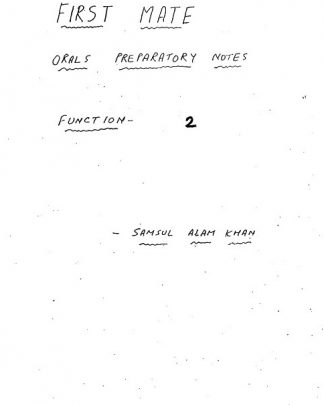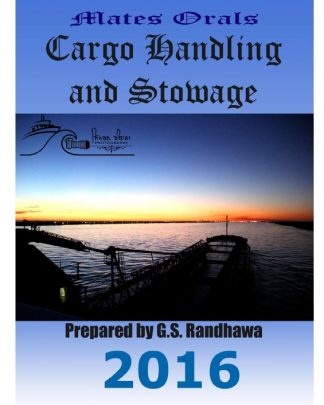Capt. Jairam Function 2 Chief Mate Orals F.G. Exams Question Set Mumbai.
DATE | SURVEYORS | QUESTIONS | FUNCTION |
| 7-SEPT-18 | JAIRAM | Angle of Repose TML, Concentrates High density Cargo Grain loading Full Chemical tanker loading full Heavy lift loading Shipper’s declaration Breaking Stress of Wire Rigging Plan | F2 |
| 6-DEC-18 | JAIRAM | Grain loading. Concentrates. How will you go about loading heavy lift with ships crane? What will happen to metacentric height when you just pick up cargo? Coal cargo loading. Angle of repose, TML. Loading of sulphur in full detail.. including chemical formulas when mixed with water. How will you prevent dust for sulphur cargo? Why would you use a spray of fw and not SW? What would contaminate the cargo? What’s the chemical formula for by product if you use SW and not fw..a lot more questions on the same topic? How will you determine TML? If shipper has declared a certain TML, and if you feel tml of cargo you’re loading is right on the borderline, what would your actions be as a mate. NOP. Who nortarizes it? Bl types. What’s a received for shipment bl, who signs it. Rigging plan. How will you go about loading steel coils, plates and what lashings you’ll use? You’ve to load 3 types of cargo on a chemical carrier, what instructions you’ll give your duty officers. IMDG code and it’s supplements.. | F2 |
| 6-DEC-18 | JAIRAM | Grain loading (each and everything) Precautions on loaded passage with Coal cargo Ship grounded, actions and if there is a hole on ships side and water coming inside tank, what is your actions as chief officer Oil spill during discharging in US port , actions Who appoints QI IMDG code contents and how many classes of IMDG cargo Formula for volumetric heeling moment | F2 |
| 12-DEC-18 | JAIRAM | Grain loading. Concentrates. How will you go about loading heavy lift with ships crane What will happen to metacentric height when you just pick up cargo Coal cargo loading. Angle of repose, tml. Loading of sulphur in full detail.. including chemical formulas when mixed with water. How will you prevent dust for sulphur cargo..why would you use a spray of fw and not SW. What would contaminate the cargo..what’s the chemical formula for byproduct if you use SW and not fw..a lot more questions on the same topic. How will you determine tml. If shipper has declared a certain tml, and if you feel tml of cargo you’re loading is right on the borderline, what would your actions be as a mate Nop. Who nortarizes it. Bl types. What’s a received for shipment bl, who signs it. Rigging plan. How will you go about loading steel coils, plates and what lashings you’ll use. You’ve to load 3 types of cargo on a chemical carrier, what instructions you’ll give your duty officers. Imdg code and it’s supplements.. | F2 |
| 9-JAN-19 | JAIRAM | Grain loading in detail Chemical tanker loading procedure Ms Reference for loading iron ore in India (MS notice 09/2010) Heavy lift precautions Gases carried in gas tankers Hazards of gas cargo Container loading and lashing in detail CSS code and csm manual Draught survey all calculations ISGOTT contents COW procedure Wall wash test dry docking with damage forward | F2 |
| 9-JAN-19 | JAIRAM | Lashing code and contents IMSBC code Loading sulphur what instructions to 2nd and 3rd officer. Sulphur dust explosion actions Why use fw and not sea water (He was not satisfied with corrosion or formation of h2so4 answer). He said as choff you should know(failing quest) IMDG classification What is COW? Types of gas carriers as per IMO What is 1G as in what is 1 and what is G? Why use IG? What is pv valve, location requirement? What is heavy lift, precautions, why vessel heels on side load is lifted (failing question)? | F2 |
| 12-MAR-19 | JAIRAM | Grain loading. Concentrates. How will you go about loading heavy lift with ships crane? What will happen to metacentric height when you just pick up cargo? Coal cargo loading. Angle of repose, tml. Loading of sulphur in full detail.. including chemical formulas when mixed with water. How will you prevent dust for sulphur cargo..why would you use a spray of fw and not SW? What would contaminate the cargo..what’s the chemical formula for byproduct if you use SW and not fw..a lot more questions on the same topic How will you determine tml If shipper has declared a certain tml, and if you feel tml of cargo you’re loading is right on the borderline, what would your actions be as a mate Nop. Who nortarizes it? Bl types? What’s a received for shipment bl, who signs it Rigging plan How will you go about loading steel coils, plates and what lashings you’ll use You’ve to load 3 types of cargo on a chemical carrier, what instructions you’ll give your duty officers IMDG code and it’s supplements.. | F2 |
| 13-MAR-19 | JAIRAM | 1. Angle of repose 2. Loading of sulphur, why sea water is not sprayed 3. Breaking stress of wire rope 4. Cow operation 5. Content of IG 6. Precaution to be taken while Loading 2 different grade of cargo in tanker 7. Timber cargo loading precaution 8. Heavy lift cargo loading precautions 9. Type of refer cargo 10. IMSBC content 11. Grain loading without DOA 12. Car loading | F2 |
| 8-APRIL-19 | JAIRAM | Hazards of Sulphur. Hazards of grain. Loading criteria for grain with DOA and without DOA. Grain loading calculation. Definition of AOR, load density. CSM manual. | F2 |
| 8-APRIL-19 | JAIRAM | -IBC code contents, IGC code. -IMSC code, Shippers declaration -Sulphur Hazards. -Coal precautions. While long voyage for at least 25 days -Loading three different grade chemical, how will u load. IMDG code contents. Heavy lift precautions, | F2 |
| 14-MAY-19 | JAIRAM | Sulphur loading and precautions. Why only FW for dust why not salt water? IMDG code in detail. Heavy lift precautions, then he went in deep about stability during lift. ISGOTT. IG system. Grain stability criteria | F2 |
| 13-AUG-19 | JAIRAM | 1. IMDG contents, classification 2. IMSBC contents, stability booklet contents 3. How will you load graIn a as Choff in America 4. How will you load coal, what precautions, what type of ventilation 5. How will you load 3 chemical cargo At one tIme such that you are arriving port, action as per choff 6. Heavy lift cargo by using Own ship gears ,precaution as Mate, what will happen to stability At each stage 7. What is lashing code (CsS) 8. What is Receipt for shipment AnD who issue it. Others don’t remember | F2 |
| 19-NOV-19 | JAIRAM | 1. Hold preparation for concentrate 2. U are carrying coal, 25 days voyage, as a Chief mate what u will do 3. P. V. Valve setting 4. U r in U. S. Waters loading oil, pollution takes place what action 5. Precautions while loading n discharging oil cargo. 6. What is load density 7. Precautions to be taken while loading heavy lift cargo. 8. Is the pressure setting and vacuum setting in P. V. Valve is same or different. | F2 |
| 13-FEB-20 | JAIRAM | Load density, angle of repose. Bulk carrier loading procedure Loading in US what extra thing . Oil spill in US waters whom to inform. Types of bill of lading. NOP. Content of IMDG ISGOTT. How will you load heavy lift. Wire breaking stress formula Loading of steel coil. How will you secure what you will check as mate. Breaking stress of that chain. Coal hazards Grain stability criteria On tanker how will load 2 grades of cargo | F2 |


